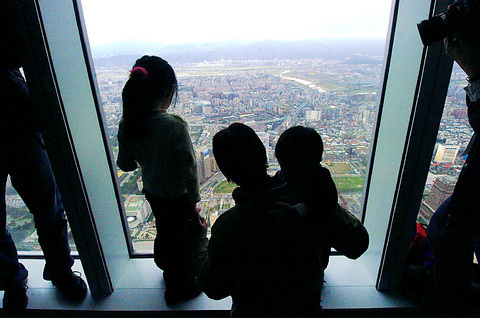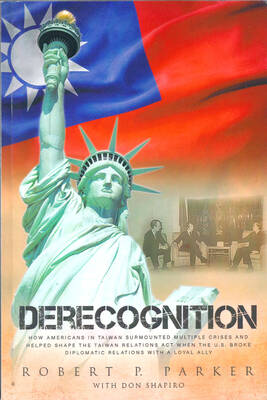At 1pm on Wednesday, the 89th-floor observation deck of Taipei 101 opened its doors to the public and within six hours the world's tallest man-made edifice had became the nation's number one tourist spot.
Exactly 2,256 visitors flocked to the tower on the opening day and many more thousands of visitors will make the trip to the 382.2m-high observation deck this weekend.

PHOTO: AFP
According to a spokesperson for 101's observation deck, the number of people expected to make the trip in the opening weeks could well exceed 150,000. The deck can accommodate only 1,396 people at one time, so be warned: you could be in for a long wait.
Once at the observation deck visitors get to enjoy a stunning 360-degree vista of Taipei City and parts of Taipei County as well as getting to eyeball the skyscraper's mammoth Canadian-designed damper, which is used to counteract strong winds and earthquakes.
For those looking to spot their apartment -- or even friends -- from the top of the world, seven NT$300,000 Japanese-manufactured telescopes equipped with lenses far more powerful than any regular camera allow visitors to zoom right in.
The telescopes are so powerful that on a clear day, individuals can be spotted and car license plates read as far away as the junction of Hsinyi and Chinshan south roads. You only get 50 seconds for NT$20, however, so you better know where and what to look for.
Along with the vistas, 101's observation deck also features a souvenir kiosk selling an assortment of 101 paraphernalia. Ranging from T-shirts and coffee mugs to key rings designed to look like the damper, sales of knick-knacks are expected to generate a staggering 50 percent of the observation deck's annual income.
From now until March, the observation deck will be open from between 1pm and 7pm, Tuesdays through Sundays. After the grand opening on March 1, however, the observatory's operating hours will be extended and it will be open from 10am to 10pm, seven days a week.
As if the view from the roof of the world weren't enough to placate those in search of adventure, getting to the observation deck is an adventure unto itself, albeit a very quick one, as visitors are able to take a ride in the world's fastest elevators.
Developed jointly by US-based elevator consultants Leach, Bates and Associates, Toshiba Japan and GFC Taiwan, the two elevators each weigh 1,600kg, can carry 24 passengers at a time, and were manufactured at a cost of NT$100 million per elevator.
The elevators reach speeds of 1,010m per minute, or 60kph, on their ascent, and a top speed of 600m per second, or 36kph, on their descent. Passengers won't get much time to enjoy these record-breaking speeds, however, as it takes only 39 seconds to go up and 46 seconds to come down.
Such speeds mean that the elevators act like airplane cabins and have been specially manufactured in order to deal with mounting air pressure. Air pressure is so strong that if not countered, it could lead to injuries such as ruptured eardrums. Each elevator is hermetically sealed and has twin air-pressure-control systems that begin to reset cabin pressure as soon as the doors are closed.
The cutting-edge elevators also offer passengers one of the smoothest rides in town. The ride is so smooth, in fact, that a NT$50 coin can be placed on its rim on the floor of the elevators and it will not move let alone topple over.
Tickets to take a ride on the world's fastest elevator and enjoy the vista from the 89th floor of the world's tallest building cost NT$350 for adults and NT$320 for children.

One of the biggest sore spots in Taiwan’s historical friendship with the US came in 1979 when US president Jimmy Carter broke off formal diplomatic relations with Taiwan’s Republic of China (ROC) government so that the US could establish relations with the People’s Republic of China (PRC). Taiwan’s derecognition came purely at China’s insistence, and the US took the deal. Retired American diplomat John Tkacik, who for almost decade surrounding that schism, from 1974 to 1982, worked in embassies in Taipei and Beijing and at the Taiwan Desk in Washington DC, recently argued in the Taipei Times that “President Carter’s derecognition

This year will go down in the history books. Taiwan faces enormous turmoil and uncertainty in the coming months. Which political parties are in a good position to handle big changes? All of the main parties are beset with challenges. Taking stock, this column examined the Taiwan People’s Party (TPP) (“Huang Kuo-chang’s choking the life out of the TPP,” May 28, page 12), the Democratic Progressive Party (DPP) (“Challenges amid choppy waters for the DPP,” June 14, page 12) and the Chinese Nationalist Party (KMT) (“KMT struggles to seize opportunities as ‘interesting times’ loom,” June 20, page 11). Times like these can

Dr. Y. Tony Yang, Associate Dean of Health Policy and Population Science at George Washington University, argued last week in a piece for the Taipei Times about former president Ma Ying-jeou (馬英九) leading a student delegation to the People’s Republic of China (PRC) that, “The real question is not whether Ma’s visit helps or hurts Taiwan — it is why Taiwan lacks a sophisticated, multi-track approach to one of the most complex geopolitical relationships in the world” (“Ma’s Visit, DPP’s Blind Spot,” June 18, page 8). Yang contends that the Democratic Progressive Party (DPP) has a blind spot: “By treating any

You can tell a lot about a generation from the contents of their cool box: nowadays the barbecue ice bucket is likely to be filled with hard seltzers, non-alcoholic beers and fluorescent BuzzBallz — a particular favorite among Gen Z. Two decades ago, it was WKD, Bacardi Breezers and the odd Smirnoff Ice bobbing in a puddle of melted ice. And while nostalgia may have brought back some alcopops, the new wave of ready-to-drink (RTD) options look and taste noticeably different. It is not just the drinks that have changed, but drinking habits too, driven in part by more health-conscious consumers and